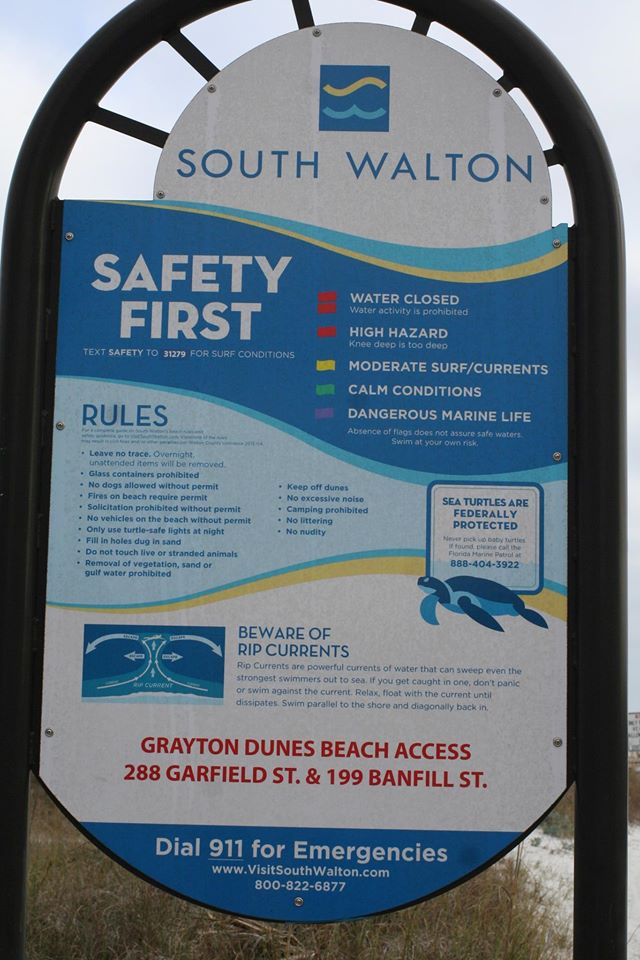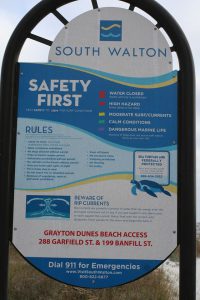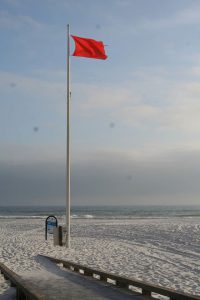
by Laura Tiu | Apr 14, 2017
It was disheartening to read that even with double red flags flying, 22 people had to be recused from the Gulf near Destin, FL recently, and one person lost their life. In that spirit, I believe it is important to review information on the importance of respecting our sometimes-unforgiving gulf.
First of all, stay calm.

Photo By: Laura Tiu
Swimmers getting caught in rip currents make up the majority of lifeguard rescues. These tips from Florida Sea Grant and the National Oceanic and Atmospheric Administration’s National Weather Service (NWS) can help you know what to do if you encounter a rip current.
What Are Rip Currents?
Rip currents are formed when water flows away from the shore in a channeled current. They may form in a break in a sandbar near the shore, or where the current is diverted by a pier or jetty.
From the shore, you can look for these clues in the water:
- A channel of choppy water.
- A difference in water color.
- A line of foam, seaweed, or debris moving out to sea.
- A break in incoming wave patterns.
If you get caught in a rip current, don’t panic! Stay calm and do not fight the current. Escape the current by swimming across it–parallel to shore–until you are out of the current. When you get out of it, swim back to the shore at an angle away from the current. If you can’t break out of the current, float or tread water until the current weakens. Then swim back to shore at an angle away from the rip current. Rip currents are powerful enough to pull even experienced swimmers away from the shore. Do not try to swim straight back to the shore against the current.
Tips for Swimming Safely
You can swim safely this summer by keeping in mind some simple rules. Many people have harmed themselves trying to rescue rip current victims, so follow these steps to help someone stuck in a rip current. Get help from a lifeguard. If a lifeguard is not present, yell instructions to the swimmer from the shore and call 9-1-1. If you are a swimmer caught in a rip current and need help, draw attention to yourself–face the shore and call or wave for help.

Photo by: Laura Tiu
How Do I Escape a Rip Current?
- Rip currents pull people away from shore, not under the water. Rip currents are not “undertows” or “rip tides.”
- Do not overestimate your swimming abilities. Be cautious at all times.
- Never swim alone.
- Swim near a lifeguard for maximum safety.
- Obey all instructions and warnings from lifeguards and signs.
- If in doubt, don’t go out!
Adapted and excerpted from: “Rip Currents” Florida Sea Grant
The Foundation for the Gator Nation, An Equal Opportunity Institution.

by Rick O'Connor | Apr 14, 2017
Growing up in the Pensacola area, I do not remember seeing many horseshoe crabs around here, but I do remember them. What I actually remember was how common they were further east in the Panama City and St. Joe area. These animals are big fans of grass beds, as are sea urchins and scallops, and all are uncommon in our area now. However, there have been local sightings in recent years, so they may be returning.

Horseshoe crabs breeding on the beach.
Photo: Florida Sea Grant
Horseshoe crabs are actually not crabs at all but members of a group of arthropods called chelicerates, which include spiders, mites, and scorpions. They differ from crabs in the absence of antenna, in which the crabs have two pairs. Their “horseshoe” shaped body is a body design to plow through the sand and mud searching for food. They are scavengers and feed on mollusk, worms, and other invertebrates – even algae at times. They do not have the large claws that blue crabs have, so they grab small bits of food where they can. Horseshoe crabs do possess a crop and gizzard and have tooth-like structures within the gizzard to grind their food. When digesting, the flesh is swallowed and the shell is regurgitated. The large spine near at the end of their bodies makes them appear similar to stingrays, which they are often confused, but the spine is actually a telson and non venomous. It is used to right itself when flipped and to push themselves in a forward direction.
They like shallow water and grassbeds are prime habitat for them. Breeding season is in the spring and early summer. During the full and new moons, both the large females and smaller males approach sandy beaches in protected areas of the bay. During the evening, they will begin to emerge into the intertidal zone where the female digs a depression and lays her eggs. The males, usually riding her back attached by a special hook, will then fertilized the eggs before they are buried. There may be more than one male trying to court the female (known as satellite males) and the numbers of horseshoe crabs on the beaches can be amazing.
Shorebirds, fish, and crabs will feed on the eggs and the young. Sea turtles are known to consume adults. Being members of the phylum Arthropoda, they will have to molt their exoskeletons as they grow. Many people will find these thin, tan-colored, molts along the shoreline.
There is a fishery for them in some parts of the southeast. They are collected for their blood, which is used in many medical processes needed for surgery and injections, and as bait for eels. The decline of these animals has been problematic for some species of migratory birds, who feed on their eggs during their migration. The horseshoe crab is also one of those rare animals that have been around longer than the dinosaurs. It would be sad to lose this animal on “our watch”. FWC is interested in where they are nesting. If you are out walking the beaches of the Florida Panhandle and encounter one of them, please contact the Sea Grant Agent at your county extension office; we are particularly interested in where they may be nesting. FWC has a website where sightings can be logged, http://www.myfwc.com/research/saltwater/crustaceans/horseshoe-crabs/documenting-beaches/.
The full and new moon cycles for spring and summer (2017) are:
Full Moon New Moon
Apr 10 Apr 26
May 10 May 25
Jun 9 Jun 23
Jul 8 Jul 23
They could nest a few days before or after. We hope you get to see one, they are pretty cool!




